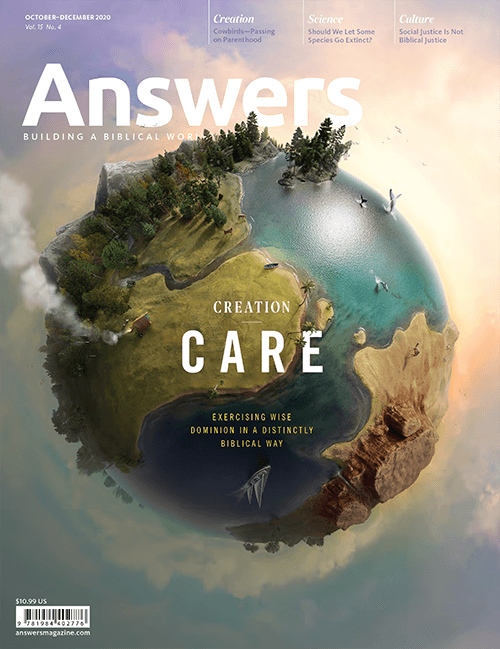Caring Past Our Prejudice
Creature Care
Ugly, worthless, annoying—does our opinion of some creatures reflect the Creator’s care or do we need an attitude adjustment?
Many people, including born-again Christians, are quite vitriolic against certain members of our Maker’s menagerie. We easily say, “I love God’s creatures” while thinking about giant pandas, box turtles, ladybugs, and koalas. But those nice platitudes evaporate when we face unlovely creatures like centipedes or goblin sharks, or perhaps troublesome critters your family has feuded with for generations, such as cockroaches, termites, or moles.
But what does God think of his creation? Genesis 1:31 says, “And God saw everything that he had made, and behold, it was very good” (emphasis added). You might say, “That was before the fall. Now it’s all twisted by the curse, and certain critters I’ve deemed more distorted are worthy of my complete loathing.”
Yes, the world is twisted, and the original created kinds have generated some species with loathsome features and behaviors. But remember, Noah built the ark after the fall. God told him to bring on board all kinds of terrestrial creatures “to keep their offspring alive on the face of all the earth” (Genesis 7:3). This means that the ancestors of the animals on our “hate list” were deliberately saved from annihilation by God’s command.
In Genesis 1:28, God told Adam and Eve, “Be fruitful and multiply and fill the earth and subdue it, and have dominion over the fish of the sea and over the birds of the heavens and over every living thing that moves on the earth.” God put us in charge of the creatures. Admittedly, many undesirable plants and animals, such as stinging nettle, venomous snakes, coyotes, or disease-transmitting insects (like mosquitoes and tsetse flies) must be kept under control for man to exercise dominion well. But our wrong attitudes should conform to a loving, wise Creator’s perspective as we obey his command to manage his creation well—even the parts we think are worthless or disgusting.
Detestable or Exquisitely Designed?
We often have an inexplicable prejudice against perfectly harmless aspects of creation, such as a variety of nonvenomous snakes, innocuous weeds, and harmless spiders. Their only “crime” is not conforming to our sense of beauty or utility. We can fix this harmful perspective by remembering that God made them and charged us with their care. Just because they aren’t as cute as a giant panda or as lovely as an orchid doesn’t mean they forfeit their rightful place on earth.
When we look closely, past our prejudice, we see that God’s design is magnificent—even if the creatures don’t measure up to our standard of beauty and utility.
In many cases, beauty can be seen in their function. For example, the naked mole-rat with its furless skin, protruding teeth, and beady eyes is perfectly suited for living underground in dark, low-oxygen conditions, chiseling tunnels with its teeth. Likewise, the blobfish, a species which often finds itself nominated as the ugliest animal, thrives in the pressure of its deep-sea habitat. Its gelatinous body allows the blobfish to float above the seafloor, reducing the energy usually needed for swimming.
When we look closely, past our prejudice, we see that God’s design is magnificent—even if the creatures don’t measure up to our standard of beauty and utility.
Worthless or Purposeful?
Sometimes the species we think are worthless are important to the health of an ecosystem. For example, many people dislike mosquitoes for obvious reasons: They annoy us on summer evenings, and in many parts of the world, they spread deadly diseases. But mosquitoes are an important food source for insectivores like dragonflies, fish, bats, and many birds. The nectar-feeding male mosquitoes also pollinate flowers.

Though mosquitoes transmit diseases to millions of people each year, these pesky insects also pollinate flowers and are a food source for other animals.
And what about thistles? These plants can mar a well-manicured lawn, but they are also a source of nectar from which bees make delicious honey.
Far from worthless, most creatures and plants offer some benefit to creation at large—including to humans. Before the 1850s, most people would have thought rats and mice were disgusting vermin only to be caught and destroyed—and rightly so, since they spread disease and ate crops. Today, however, these rodents are invaluable to biomedical research. Likewise, thale cress (Arabidopsis thaliana) in the wild is considered an annual weed. But because of its quick life cycle and small genome, it has become a popular and valuable model organism in plant biology and molecular genetics.
We must watch for possible assets in plants and animals that we currently disregard. We don’t know what hidden treasures might lie in some seemingly useless or unpopular organisms. Regarding biodiversity conservation, ecologist Aldo Leopold wrote in his book A Sand County Almanac, “Who but a fool would discard seemingly useless parts. To keep every cog and wheel is the first precaution of intelligent tinkering.”
Annihilate or Manage?
Rather than trying to annihilate a troublesome species, managing creation means finding ways to reduce the negative effects of the fall while still maintaining God’s biodiversity. For example, rather than driving mosquitoes to extinction, scientists are working on genetically modifying the insects to inhibit their ability to transmit malaria.
In addition to researching ways to control the negative effects of creation, we can also manage creatures by keeping them in their proper ecosystems. Whether by human intent or carelessness, certain species often wind up in the wrong place. These are known as invasive species. For example, the Asian giant hornet was recently introduced into northwest Washington State and Canada. Honeybee (Apis mellifera) colonies are defenseless against this marauder, which decapitates the bees by the dozens. But in the hornet’s natural habitat, Japanese honeybees (Apis cerana japonica) know how to deal with this bully. Like a rugby scrum, they mob the hornet. Then they vibrate their wing muscles until they generate enough heat to cook the attacker.
When invasive plants or animals get established in a new place, they can cause enormous, expensive problems because they are free from the environment that normally held them in check. If these so-called pests are kept in their proper place, they usually aren’t much of a problem. They don’t need to be exterminated off the face of the earth—they just need to be managed.
Reappraising Their Value
If a species’ existence hinges on our opinion, the cute and furry species are safe. But it’s another story if the critter is a venomous snake, like the Russell’s viper, responsible for thousands of deaths each year, or insatiable slugs that eat our garden vegetables. These creatures are hard-pressed to justify their existence to the general public. (Personally, I think snakes are amazing. But my opinion doesn’t matter.)
Even though there are many aesthetic or pragmatic reasons for finding the value in creatures, the foundational reason to respect animal or plant species should not be attached to their ability to win a popularity contest. We might not think certain animals or plants are particularly useful, pretty, or interesting, but we do know they have innate value simply because they are part of God’s creation and he gave them to us to manage.
The Dominion Mandate Still Stands
Remember, even though creatures were cursed following the fall, the dominion mandate still stands. We are to wisely and kindly rule over creation. That starts by adjusting our attitudes toward the creatures in our care. Plants and animals shouldn’t have to justify their existence to us by meeting our standard for beauty or having some obvious benefit to bestow on society or their ecosystem, though they probably do. Their intrinsic value is not dependent on our attitude toward them. Their innate value is established in the words of Genesis: “He saw all that he made, and it was very good. . . . God said to them, . . . ‘Have dominion over . . . every living thing that moves on the earth.’” Because these are God’s creatures and because he gave them into our charge, it’s up to us to manage them well—including keeping pests in check as appropriate—to the glory of our Creator.
Adapted from excerpts in A Different Shade of Green: A Biblical Approach to Environmentalism and the Dominion Mandate by Gordon Wilson (Moscow, ID: Canon Press, 2019).
Answers Magazine
October–December 2020
When it comes to creation care, Christians have a deeper calling than secular environmentalists.
Browse Issue SubscribeRecommended Resources

Answers in Genesis is an apologetics ministry, dedicated to helping Christians defend their faith and proclaim the good news of Jesus Christ.
- Customer Service 800.778.3390
- © 2024 Answers in Genesis







